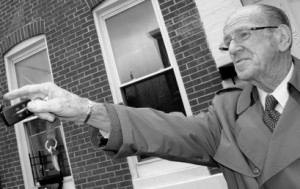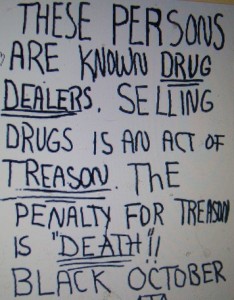A Voice of Baltimore Feature, an excerpt from
BLACK OCTOBER AND THE MURDER OF TURK SCOTT
The Case Files of Homicide Lt. Stephen Tabeling
A SOON-TO-BE-PUBLISHED MINI-eBOOK ON AMAZON.COM
By Stephen Tabeling and Stephen Janis
Baltimore City, like most communities, has a split personality.
Within its borders, alleys and back-ways two parallel worlds exist side by side. Distinct civic selves, which become self- evident if you spend enough time immersed in both.
I know this because I was… and still am, a cop.
During my career as a Lieutenant in Baltimore City Homicide, I often worked at a crossroads where the two worlds met. At the point where healthy productive communities and the criminal element clashed.
And while I worked dozens of murder cases and headed a variety of investigations, there is one case that to this day stands out as emblematic of the split personality that characterizes this town.
This case defined just how destructive the burgeoning drug war in Baltimore was to become; and just how complicated and costly fighting it would be.
It was a case that pitted the city against itself, and revealed how scars of divisive racial mistrust would be slow to heal — if ever they would heal at all.
It was a case that has all but been forgotten, although it sowed the seeds of many of the problems that hamper the effectiveness of our justice system even today.
It was also a story of a social movement that threatened to engulf the city in civil war, a vigilante movement which still remains in part, a mystery.
I’m talking about the murder of Maryland State Delegate Turk Scott.
BETWEEN THE HEALTHY AND THE UNHEALTHY
For most of my career I was an investigator, a detective, a person whose beat was the juncture of the aforementioned divide between the healthy and the unhealthy.
And when it came time for me to do my job, I tried, for lack of a better analogy, to be precise, and dogged. I mean methodical, hard-nosed, but within the law. I didn’t fight violence by abandoning the law; indeed, I embraced it. I was “the law,” so I acted like it. But I also acted within it.
That’s been the mantra of my career — to follow, teach, and learn the law; it’s the only way to police effectively.
To insure that cops remain peacekeepers and community builders, simply demands they follow the law. Because when your job is to literally stand on the precipice of communal dysfunction, the law keeps the chaos at bay.
That’s why the law has evolved. That’s why it has to be followed.
And in the murder of James “Turk” Scott, it was all I had.
AN UNWIELDY CASE AT SUTTON PLACE
It’s a strange life, being at the nexus of all things violent. In the City of Baltimore, which numbered almost a million people when I was a homicide investigator, if someone found a body with a bullet hole in it they called us.
This is why a ringing telephone on the floor of the homicide division always had a sinister undertone. Like a perversion of Zuzu’s wing-earning angels, when the bell chimed in our office, it meant someone had just met a violent end.
And if that call was from a homicide detective who was already on the scene of a murder to tell me I needed to “see this,” I always knew there was something extraordinary attached to the body that lay prone and lifeless in some back alley or on a sidewalk in the city’s urban hinterlands.
But nothing really prepared me for the murder, and its aftermath, that began with an early a.m. Friday the 13th phone call from one of my detectives who was standing in the parking garage at the Sutton Place Apartments on that morning in July, 1973.
It was a grisly scene, yes.
VICTIM WAS WEARING BEIGE SUIT AND PAISLEY TIE
A middle-aged African-American male lay on the parking garage floor surrounded by at least a dozen shotgun casings and spent slugs. The victim was dressed in a beige suit and paisley tie; blood-spotted entry wounds were visible on both his chest and lower leg.
But what caught my eye that morning, and what would ultimately draw this case into a firestorm of controversy was something else. Something you rarely see at a crime scene. I guess you could call it a message of sorts… and it wasn’t subtle.
Strewn about the body like leftover litter from a raucous Irish wake were leaflets — dozens of them. All emblazoned with the name of a group that we had recently become aware of, but at that time had few clues to just how violent it would become.
Black October.
Allegedly named after an organized effort during the Vietnam War to aid heroin-addicted African-American soldiers, the group had come to our attention when another suspected city drug dealer was gunned down in broad daylight.
And now inscribed on the sheets of paper strewn across the parking garage was a short but succinct threat, a posthumous death sentence for Turk Scott and a warning of more trouble to come:
“These persons are known drug dealers,” the flyers proclaimed. “Selling drugs is an act of treason. The penalty for treason is ‘death’!! [signed] Black October”

Stephen Tabeling, pictured here, is co-author of soon-to-be- published mini-eBook series on Baltimore homicide, co-writ- ten by Fox45-TV Investigative News Producer Stephen Janis.
ABOUT THE AUTHORS
and the mini-eBooks:
He was the first detective to win a murder conviction without a body. A cop who investigated the attempted murder of former Mayor William Donald Schaefer. A detective who was on the scene when a sniper shot seven Baltimore police officers in the bloodiest day of violence in the history of the city force.
Put simply, former Lieutenant Stephen Tabeling’s history and the history of the city he served are one and the same.
And now the man who started out walking a beat in Northwest Baltimore but later supervised some of the most consequential criminal investigations in the annals of this city is opening his case files, and his conscience, for all to see.
In a series of mini-eBooks, Tabeling takes readers on a tour through the shadowy back alleys of Baltimore City crime, revealing for the first time details of cases that once made headlines. In straightforward, spare and descriptive prose, Tabeling’s case files offer a frank insider’s take on the task of investigating death, drug dealing, and how violent crime evolved in a city that has since become engulfed in it.
“Understanding the history of crime in this city is important to understanding where we are today,” Tabeling told Voice of Baltimore in discussing the upcoming eBooks, which are co-written by Fox45 Investigative News Producer Stephen Janis. “I think by sharing some of the back story on past crime they will shed some light on the present,” he explained.
In the first “case file,” Tabeling recounts the murder of former Maryland State Delegate James “Turk” Scott, and his investigation into the mysterious vigilante group tied to Scott’s killing, known as “Black October.”
A POLITICALLY CONNECTED BAIL BONDSMAN
Scott was a politically connected bail bondsman who was indicted for distributing heroin shortly before he was gunned down in a city parking garage. Tabeling led an investigation that brought police to the doorstep of one of the city’s most illustrious families. An investigation that led to the arrest of Sherman Dobson, a then-20-year-old nephew of prominent Baltimore Pastor and Civil Rights Activist Vernon Dobson.
“It was a case that transfixed the city, and I think it influences our criminal justice system to this day,” Tabeling said.
The second case file reveals details behind a lengthy investigation of an illicit gambling operation on Pennsylvania Avenue, and the surprising suspects Tabeling tracked down. He also discusses the near career-ending consequences for him that followed the high profile probe.
Then in upcoming mini-eBooks, Tabeling shares his insights into police training, the law, and what he thinks needs to change.
“These eBooks are not just about cases, I want to share what I learned for the betterment of police today,” Tabeling said.
In the fall, Tabeling and Janis will release a print volume that will include all of the most intriguing cases from the mini-eBooks. To be, as herein, previewed exclusively by Voice of Baltimore.







April 23rd, 2012 - 5:54 AM
Our Nation and our Constitution are constantly under attack from misguided, self-righteous neo-puritans and degenerate, authoritarian demagogues whose ignorant and irrational minds traverse a fantasy plane of existence in search of the absurd and unattainable utopia of an addiction/drug/risk free society.
Try this simple Google search: “Fatty foods may be just as addictive as heroin and cocaine.”
On July 9, 2009, the California Center for Public Health Advocacy (CCPHA) released ‘The Economic Costs of Overweight, Obesity and Physical Inactivity Among California Adults’. The study found that the cost of obesity and physical inactivity had climbed to $41 billion in 2006, nearly double the amount reported in 2000.
Does this mean that we should now target fat people for persecution and mass incarceration? Or that we should hand the market in Twinkies and Ding Dongs to street punks, Mexican cartels, and the terrorists of al-Qaeda?
“There are 100,000 total Ding Dong consumers in the US, and most are Negroes, Hispanics, Filipinos and Activists. Their Satanic music, jazz and swing, result from Ding Dong usage. These Ding Dongs cause white women to seek sexual relations with Negroes and entertainers.”
“Ding Dongs lead to pacifism and communist brainwashing.”
“Ding Dongs are the most violence-causing drug in the history of mankind.”
“You eat a Ding Dong and you’re likely to kill your brother.”
– Harry J. Anslinger ..
Ding Dongs are a gateway food: They impair a person’s ability to make healthy choices. They may lead directly to Ho Hos, Ben and Jerry’s, and cheese cake! – Are you listening FDA? This is outrageous! CREAM FILLINGS ARE A SCAM!!!
— You literally couldn’t dream this s**t up!
May 21st, 2012 - 12:02 AM
[…] Detective Stephen Tabeling as told to Fox45 Investigative Producer Stephen Janis. For details on the murder of Del. Turk Scott see EXCERPT 1 of Black October on Voice of Baltimore&nb… People get killed violently for a whole variety of reasons. But in the 1970s, as I’m sure […]
June 20th, 2012 - 1:29 PM
I was fortunate to meet steve a few years ago and i found him to be one of the intelligent and well spoken men i have ever met. The book is sure to be a intriguing look into baltimore police departments dark and corrupt past and its current struggles to conceal the truth from everyone!
August 6th, 2012 - 12:03 AM
[…] advance excerpts have been published by Voice of Baltimore in April and May (click here and here) and a third excerpt will appear in this space this […]
August 12th, 2012 - 1:33 AM
[…] Homicide Detective Stephen Tabeling as told to Fox45 Investigative Producer Stephen Janis. For details on the murder of Del. Turk Scott see EXCERPTS 1 & 2 of Black October on Voice of Ba… and (here) CHAPTER 2: Gambling on […]
October 31st, 2013 - 9:27 PM
[…] on VoB may be found under the title, Black October and the Murder of Turk Scott by clicking here, here and here. Filed under: Top Stories Comment […]